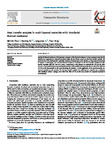Heat transfer analysis in multi-layered materials with interfacial thermal resistance
| dc.contributor.author | Yuan, W-B | |
| dc.contributor.author | Yu, N | |
| dc.contributor.author | Li, Long-yuan | |
| dc.contributor.author | Fang, Y | |
| dc.date.accessioned | 2022-06-21T09:47:59Z | |
| dc.date.available | 2022-06-21T09:47:59Z | |
| dc.date.issued | 2022-08-01 | |
| dc.identifier.issn | 0263-8223 | |
| dc.identifier.issn | 1879-1085 | |
| dc.identifier.other | 115728 | |
| dc.identifier.uri | http://hdl.handle.net/10026.1/19324 | |
| dc.description.abstract |
Interfacial thermal resistance (ITR) presents a measure of the thermal resistance to heat transport caused by the interface in composites to a thermal movement when the heat flows across it. In the heat transfer analysis, the presence of an ITR invalidates the continuity condition of temperature at the interface, so that a special treatment is required. In this paper, two one-dimensional models are developed for the heat transfer analysis in multi-layered materials with ITR. One is to create a virtual layer at the interface to represent the ITR and the other is to use a local artificial layer surrounding the interface with modified thermal properties to reflect the influence of ITR on the heat transfer in the layer involving the interface. As the application of the present models, numerical examples are also provided for the heat transfer analysis of a multi-layered composite and a substrate with multilayer surface coatings, from which the effect of ITR on the heat transfer in composite materials is demonstrated. | |
| dc.format.extent | 115728-115728 | |
| dc.language | en | |
| dc.language.iso | en | |
| dc.publisher | Elsevier | |
| dc.subject | Heat transfer | |
| dc.subject | Multilayer | |
| dc.subject | Composites | |
| dc.subject | Interfacial thermal resistance | |
| dc.subject | Thermal barrier coatings | |
| dc.title | Heat transfer analysis in multi-layered materials with interfacial thermal resistance | |
| dc.type | journal-article | |
| dc.type | Journal Article | |
| plymouth.author-url | https://www.webofscience.com/api/gateway?GWVersion=2&SrcApp=PARTNER_APP&SrcAuth=LinksAMR&KeyUT=WOS:000824464400001&DestLinkType=FullRecord&DestApp=ALL_WOS&UsrCustomerID=11bb513d99f797142bcfeffcc58ea008 | |
| plymouth.volume | 293 | |
| plymouth.publication-status | Published | |
| plymouth.journal | Composite Structures | |
| dc.identifier.doi | 10.1016/j.compstruct.2022.115728 | |
| plymouth.organisational-group | /Plymouth | |
| plymouth.organisational-group | /Plymouth/Faculty of Science and Engineering | |
| plymouth.organisational-group | /Plymouth/Faculty of Science and Engineering/School of Engineering, Computing and Mathematics | |
| plymouth.organisational-group | /Plymouth/REF 2021 Researchers by UoA | |
| plymouth.organisational-group | /Plymouth/REF 2021 Researchers by UoA/UoA12 Engineering | |
| plymouth.organisational-group | /Plymouth/Research Groups | |
| plymouth.organisational-group | /Plymouth/Research Groups/Marine Institute | |
| plymouth.organisational-group | /Plymouth/Users by role | |
| plymouth.organisational-group | /Plymouth/Users by role/Academics | |
| dcterms.dateAccepted | 2022-05-08 | |
| dc.rights.embargodate | 2022-6-22 | |
| dc.identifier.eissn | 1879-1085 | |
| dc.rights.embargoperiod | Not known | |
| rioxxterms.versionofrecord | 10.1016/j.compstruct.2022.115728 | |
| rioxxterms.licenseref.uri | http://www.rioxx.net/licenses/all-rights-reserved | |
| rioxxterms.type | Journal Article/Review |


